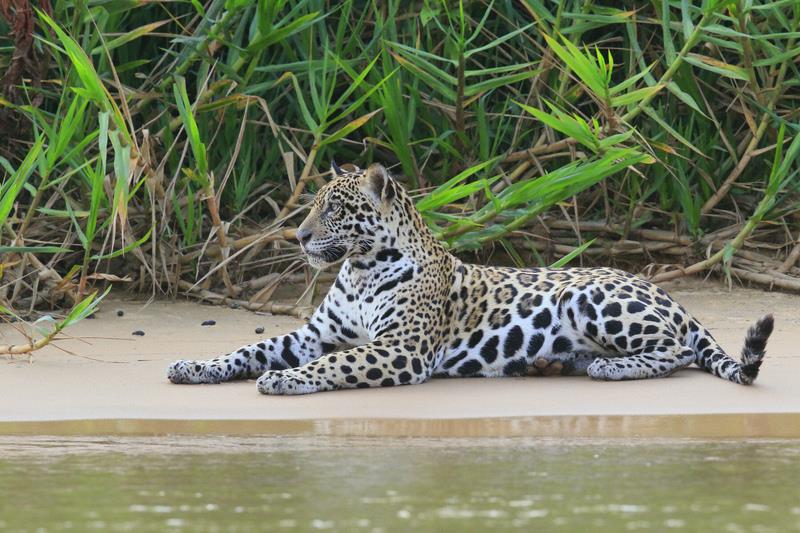Come and be inspired
Jaguars (and some other mammals)
Mondo Verde
The Pantanal, Brazil.
Photos by Bob Gress, Tour Leader.
Mondo Verde Expeditions
September 8-25, 2019.
Brazil’s Pantanal is a wildlife paradise. It’s probably best known as the jaguar watching capital of the world! Those of us on this Mondo Verde Expedition were interested in seeing jaguars and other mammals, birds, reptiles, amphibians, insects, plants and more – and we did! My next PhotoBlast will highlight some of the birds of the Pantanal.
The Pantanal is the world’s largest wetland. Estimates of its size vary from 50,000 to 80,000 square miles. Most of the Pantanal lies in Brazil, but parts of this wetland overlap into Bolivia and Paraguay. Its BIG! Annual rainfall determines the size of the wetlands. For perspective, prior to some drainage, Florida’s Everglades covered 4,000 square miles.
The best time to visit is during the dry season. The wet season usually begins in November or December and runs through March. The main source of water is the Paraguay River basin fed with waters from the adjacent highlands. Additional flow comes from the Taquari, Miranda, Negro, Cuiaba, and Aquidauana rivers. These slow-flowing rivers flood large areas of flat plains.
From Sao Paulo, we flew to Cuiaba, in the state of Mato Grosso, at the northern end of the Pantanal. The Transpantaneira is the only road to penetrate deep into the Pantanal.


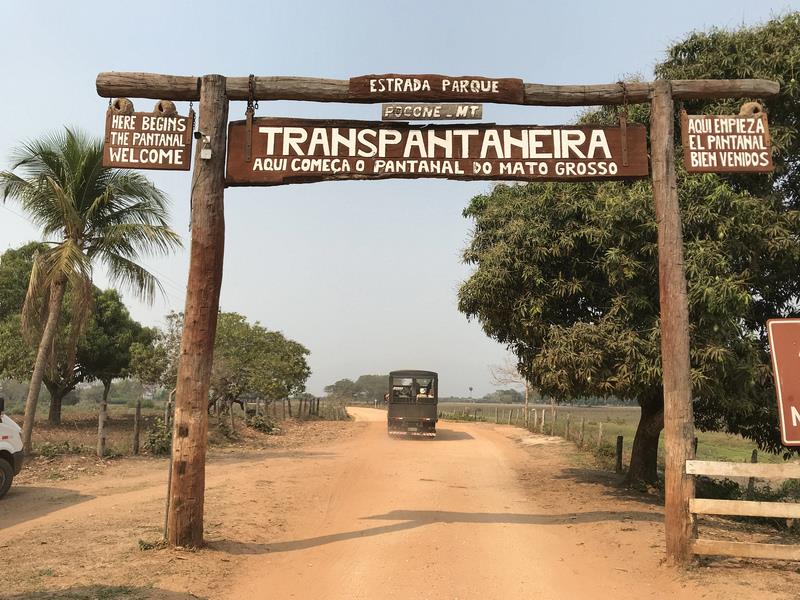
The Transpantaneira road extends from the small town of Pocone to the tiny settlement of Porto Jofre which sits on the edge of the Cuiaba River. The road is unpaved, 92 miles long, with 126 wooden bridges and 44 concrete bridges. During our visit in September the wetlands were mostly dry. Occasional roadside wetlands and roadside ditches holding shrinking pools of water concentrated the wildlife into small areas relatively close for viewing.
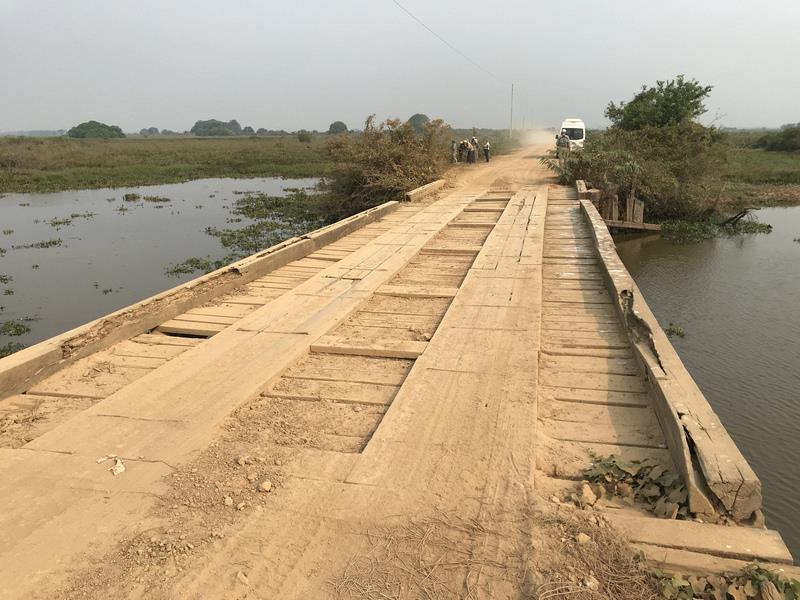

Among the rarest mammals to inhabit the Pantanal are the Marsh Deer (above) and the Giant Otter (below). Both are jaguar prey. Marsh deer, although relatively rare, concentrate near water during the dry season and are frequently seen near the road. Giant otters are found in the rivers. Male otters may weigh 60+ pounds. They live in cohesive families of up to eight individuals, are active by day and communicate loudly!
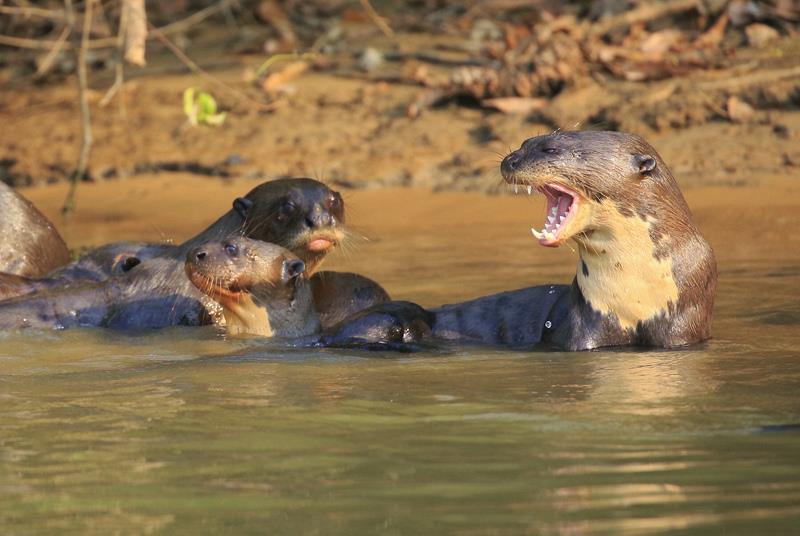

The Crab-eating Fox (above) is the Pantanal’s most common canid. During the wet season crabs dominate its diet. During the dry season it eats small mammals, amphibians, reptiles, fruits, seeds and is often seen foraging around ranches.
Capybaras (below) are the world’s largest rodent with some weighing over 100 pounds. They are social, abundant, tame and entertaining to watch. They hang out in family groups of up to six and sometimes in herds of dozens. They’re always near water, are excellent swimmers and have partially webbed feet. They can hold their breath for several minutes which is useful when avoiding hunting jaguars.
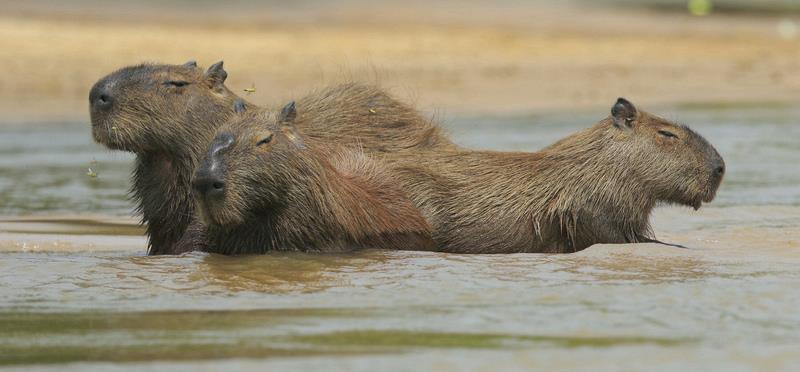
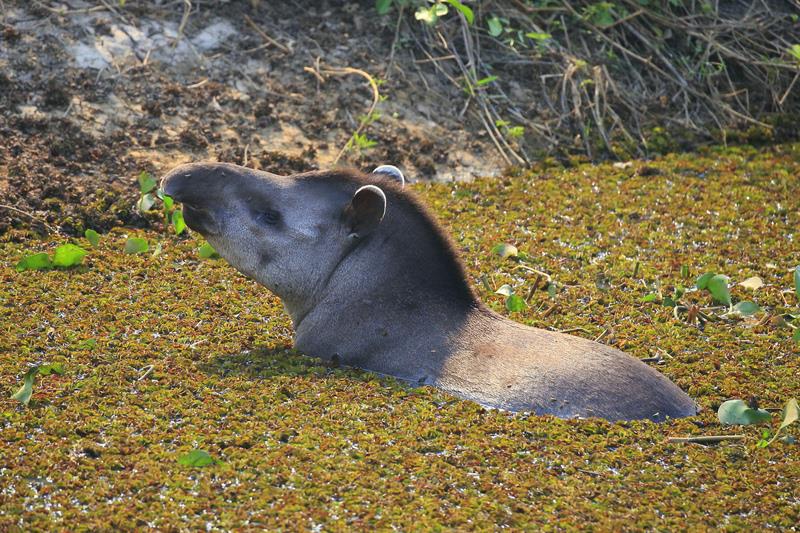
The South American Tapir, at over 500 pounds, is the heaviest land mammal in South America. Although normally hard to find, we were lucky and saw four of them. Tapir’s upper lips and nose are stretched out into elongated snouts that resemble miniature elephant trunks. They’re helpful in reaching low hanging fruits and vegetation.

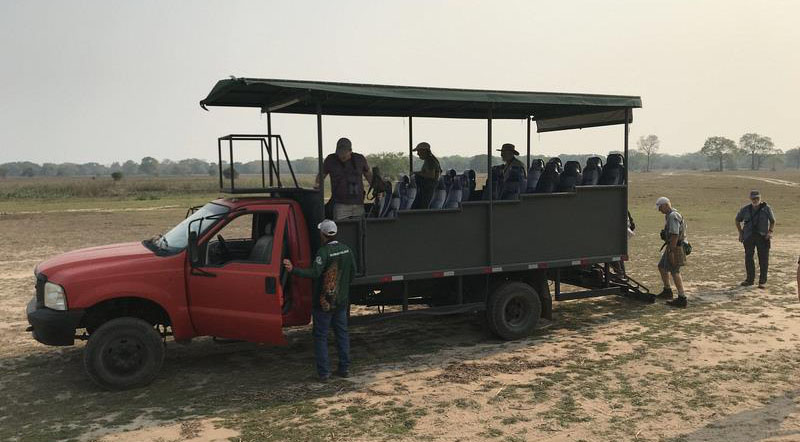
Jaguars! Pousada Piuval is a working ranch but also a tourist destination featuring lodging, restaurant, swimming pool, bar and tours. At 8:00 p.m., in the dark, we boarded the truck (above) for what was supposed to be an hour spotlighting tour. Two and a half hours later our driver and guide commented that we had experienced an exceptional outing. We saw 2 tapirs, 3 red brocket deer, 2 crab-eating foxes, 20 capybaras, 100+ Yacare caimans and 2 jaguars! We didn’t get very close to the jaguars but I managed this blurry photo (below) using the truck’s spotlights. Jaguars are normally solitary. This was likely a female in estrus with an attending male.
Jaguar encounter duration: 16 minutes

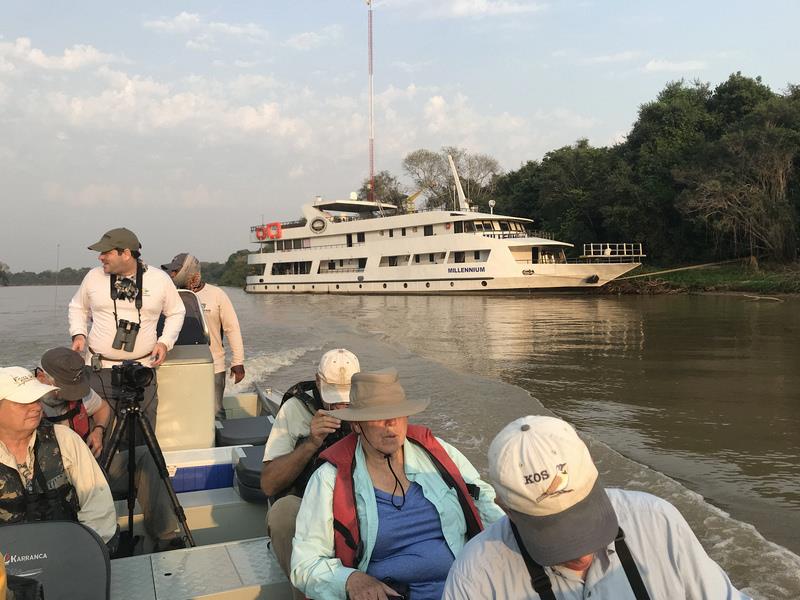
The jaguar watching season runs for about four months during the dry season, usually from July to October. To accommodate photographers and wildlife watchers from around the world, a half dozen yachts are brought up river from the coast to provide food and lodging. We spent 4 nights on the Millennum (above) and spent three days on the rivers in the smaller tour boat looking for birds and jaguars.

At sunrise we were searching for birds on the Cuiaba River. Late morning our boat driver heard via radio of a jaguar sighting. Off we went at full speed. This turned out to be an amazing encounter between this hunting female (above), watching a family of six giant otters (below). The otters barked and screamed at her from the river. The jaguar launched down the bank and grabbed a youngster from the water’s edge. As a pack, the four adult otters charged screaming at the jaguar and nipping at her heals. The scrambling, panicked jaguar dropped the youngster in her escape. But the youngster had already been dealt a lethal bite. The snarling jaguar at the top of this PhotoBlast was snarling at the otters after dropping the baby. The otters retrieved the body and spent many minutes trying to get the baby to respond. Eventually they disappeared down river with the dead baby in tow.
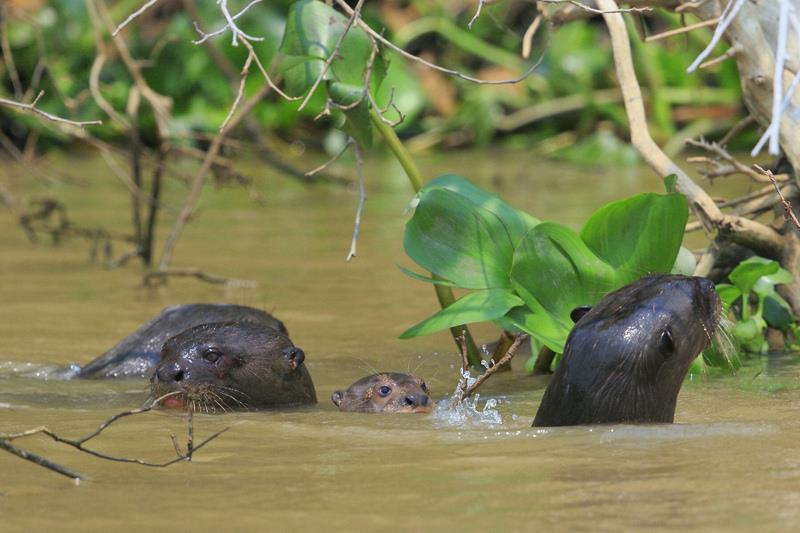

After the otter family disappeared downstream the jaguar (above) explored the dark entrance to the otter’s communal den called a “holt”.
Jaguar encounter duration: 29 minutes

Later that afternoon another jaguar was located. This turned out to be another female who was quite comfortable being watched while catching some sun on a tree trunk that had fallen into the river. She watched a growing semicircle of boats filled with photographers (below), laid down, spent some time cleaning herself then tried to bore the people in the boats by taking a nap while we roasted. It was hot! Perhaps 105 degrees, no breeze, sitting in a metal boat in the full sun. We felt like eggs in a skillet.
Jaguar encounter duration: 79 minutes

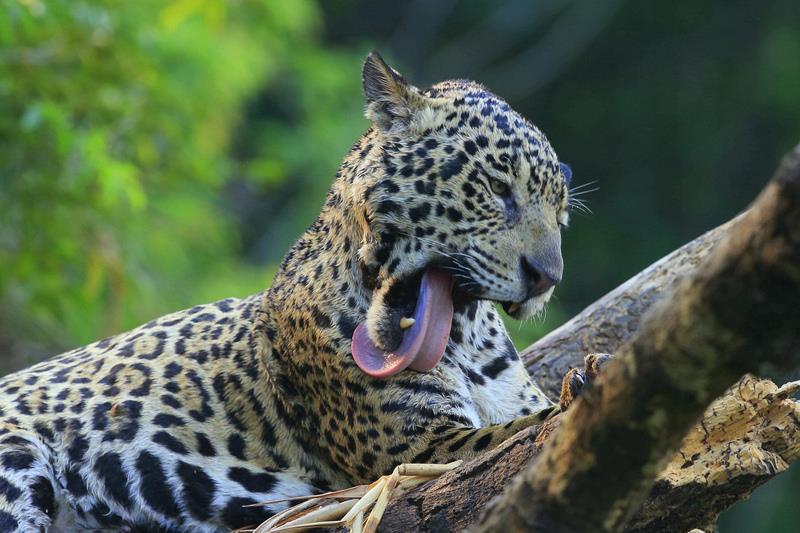

The last jaguar sighting that day was at dusk. This large male (above) was walking along a sandbar. After about 150 yards he laid down for a short time then walked back along the sandbar in the direction he had come. Check out the size of his head (below). Powerful large-headed males may weigh 300 pounds and bites can crush turtle shells and skulls. In the Pantanal their main prey are Yacare caimans, which are alligator-like reptiles.
Jaguars are the largest cat in the Americas and join the Lion, Tiger and Leopard as roaring cats. Roaring cats belong to the subfamily of Pantherinae while the smaller, purring cats belong to the subfamily Felinae.
Jaguar encounter duration: 18 minutes

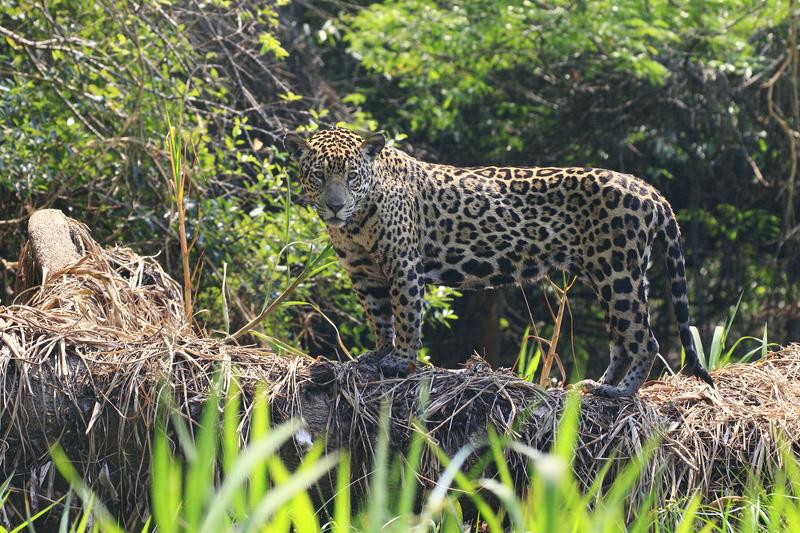
The next morning we relocated the female (above) that had gathered the collection of boats the day before. She had selected a different tree sprawling over the river several hundred yards away. Jaguars have unique patterns of head markings allowing individuals to be recognized.
Jaguar encounter duration: 17 minutes
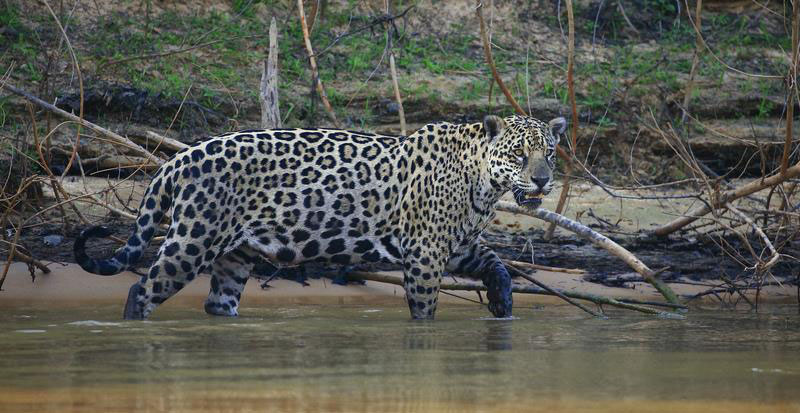
Later in the afernoon we found another female jaguar hunting along the edge of the river (above). Jaguars are comfortable in the water and are excellent swimmers. This female spotted two capybaras resting on the riverbank ahead. She took to the water and approached one slow step at a time, behind a tangle of branches, to withing 50 feet. She remained half-submerged in this spot, watching the capybaras, for an hour and 15 minutes (below).

It was too dark for photos when the jaguar made her sprint for the capybaras. The capybaras dove immediately into the water with the jaguar in pursuit. All went under water for several seconds before the jaguar surfaced empty-mouthed. The capybaras eventually came up in the middle of the river barking with excitement. That’s a Cattle Tyrant perching on the nose of the capybara picking off ticks and flies.
Jaguar encounter duration: 111 minutes.

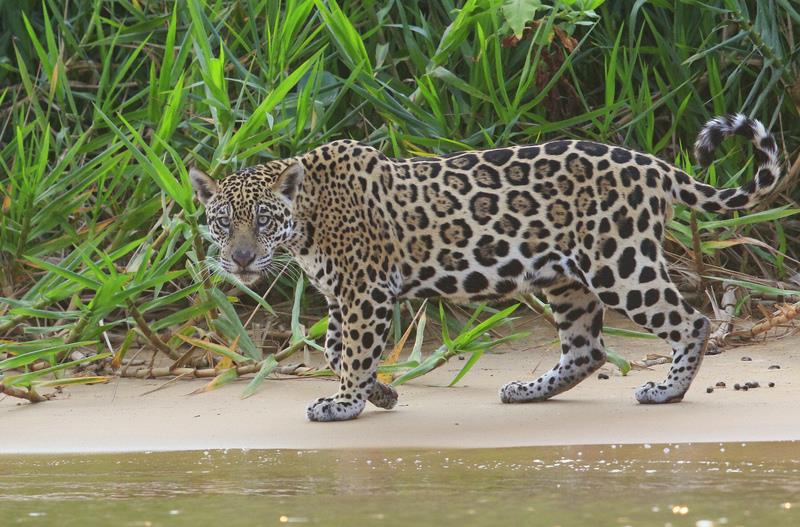
Our last jaguar sighting was on our third day (above). There were no other boats around and he remained for only a few minutes. Our guide thought this young male was 2-3 years old and looked in great condition. His head was relatively small. He laid down, looked around a while (below) then disappeared back up the riverbank. The day was cooler and comfortable and no other boats found jaguars that day.
Jaguar encounter duration: 4 minutes
